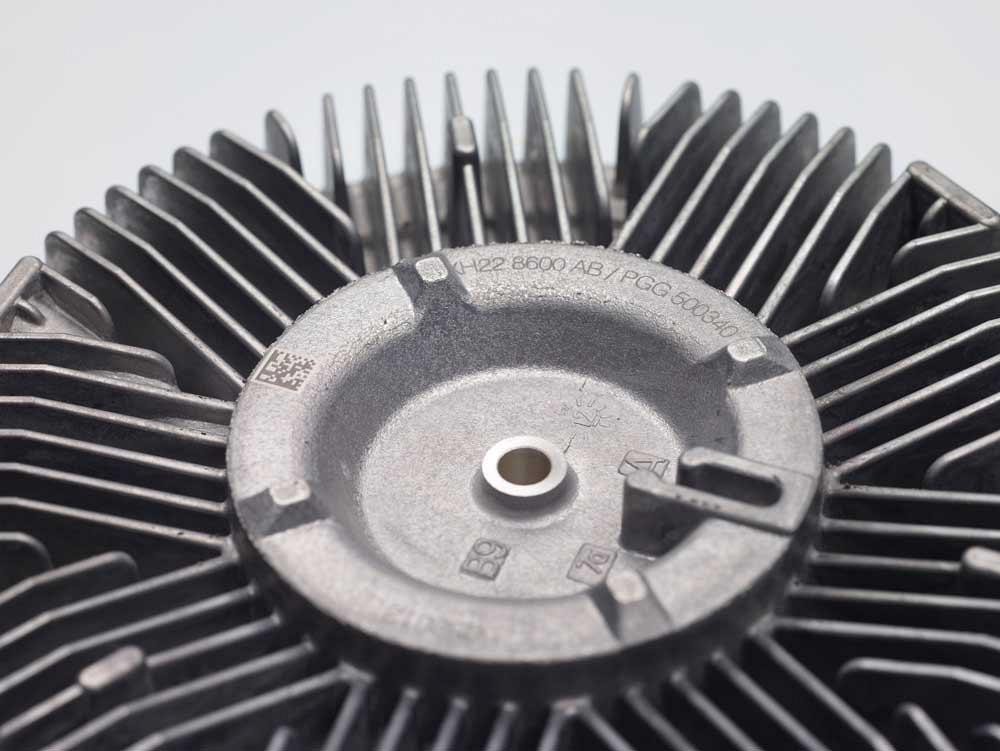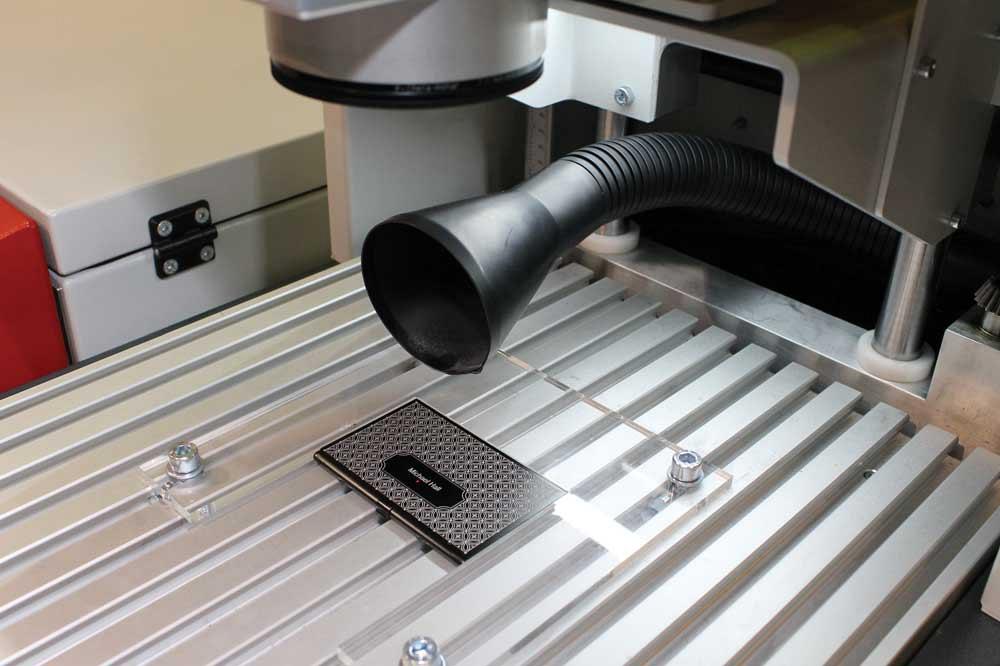Associate Editor
- FMA
- The Fabricator
- FABTECH
- Canadian Metalworking
Laser marking for metal part identification
Manufacturers are relying more and more on laser marking, not only for brand recognition, but for part identification and traceability.
- By Lindsay Luminoso
- August 28, 2018
- Article
- Fabricating

Laser marking is becoming increasingly necessary with expanded regulations requiring engraving on manufactured products for labelling, identifying, and security purposes.
The global laser marking machine market was estimated at US$2.21 billion in 2016 and is expected to grow to US$3.38 billion by 2024, according to a “Global Laser Marking Machine Market Size and Forecast, 2014-2024,” a report by HexaResearch. The variety of laser marking products available across numerous price ranges has had a positive effect, yet high initial investment has limited expansive market growth.
Of all segments (CO2, Fibre, Green, UV, and YAG lasers), the fibre laser marking machine market is expected to see the fastest growth due to the system’s flexibility and easy integration in production lines.
For applications, the machine tool market was the largest segment in 2016, accounting for 30.7 per cent of the overall laser marking market. With expanded regulations for engraving on manufactured products for labelling, identifying, and security purposes, this segment is expecting rapid growth.
Mike Clarke, a sales representative for Trotec Laser Canada, Mississauga, Ont., recently discussed the latest laser marking and part identification technologies and market trends with Canadian Fabricating & Welding.
What are the advantages of the different part marking technologies on the market?
When we look at an actual part marking, we are normally talking about dot peen or an actual impression made with a tool. That can be done in a couple of ways: either a tool coming down in rapid succession or by punching the image onto the product.
There is also the diamond scratch method, which you would normally see in a trophy shop, for example. This technology uses an industrial diamond to scratch onto the surface. The challenges then become readability and part damage. For example, if you are trying to put a mark on a precision-fabricated part, you typically don’t want to remove material or cause any impressions because it might not be balanced properly or it will cause structural issues. So these methods are not necessarily ideal for this type of application.
Laser etching could be a solution. There are generally two ways you can etch. One way is that you can remove material, which can also cause issues like the dot peen and diamond scratch. The part also can be annealed, where you get a black mark without removing any material, but you still have good readability. Typically, laser annealing is faster in terms of making the mark and is done with fewer structural issues on the part and better readability.
When it comes to choosing the right machine, it tends to come down to cost and application. The laser works better in a production environment, like on a conveyor system, because it can pull information quickly and better for production flow. If a shop is not marking a lot of pieces, then it might look at another alternative for marking.
Why is part traceability important in today’s manufacturing setting?
With part tracing, we typically see customers putting on a barcode or standard text information, not simply adding their logo. The reason part traceability needs to be there is if a part fails, you need to know where the part came from and what supplier information is available.
Manufacturers may rely on several different suppliers in various locations and need to be able to access that information if they need to go back to the source. For example, if there is an automotive recall, customers need to know exactly where the part came from and go back to fix the problem.

The Trotec ProMaker 300 galvo-style fibre laser system can mark even the smallest details on a part.
It could also be that a manufacturer is making the same part for several suppliers that all want their logo on it for when the distribute it—like in an OEM scenario. That’s also why they might want to put a part mark on it.
Some manufacturers like to include a mark with part number and information to make iteasier for customers to buy replacement parts. So not only is it important from a traceability standpoint but also ease of ordering and brand identification.
Where is the bulk of buying activity taking place?
For years, people really didn’t worry about part identification. If you look at what’s going on with NAFTA right now, we see a lot of the car companies that have parts come from Canada and then into the U.S., then back into Canada, with the final product going back into the U.S. That traceability is so important because you need to know where that part is coming from.
From a growth perspective, we are seeing it from people who are producing parts that are being put into a bigger product, like a fly wheel, brake drum, and manifold. We are getting to the point where all parts going into a larger component need to have that identification mark. We see part marking as a growth industry on all pieces that are being manufactured.
What factors need to be considered when marking on different materials?
Typically, we are talking about fibre or YAG lasers. If we are looking at an anodized aluminum part, you can use either a fibre or CO2 laser—fibre is typically a metal marking machine and CO2 is typically a non-metal marking machine. CO2 works well on anodized aluminum. If you want it to mark on tool or stainless steel using a CO2 source, you must use a pre-spray on that. That becomes problematic because of its lack of durability.
When it comes to working on titanium or steel, the question becomes: Am I going to ablate the material, remove material, or am I going do an annealed mark? That is the first step that goes into the process. The second step is to look at how to get the information into the machine. Is it done by operator input; or when a work order comes in, does the information populate in the software; or does it come from an external database in a company off-site? These are key questions to ask before deciding on the right system.
Does a laser marking machine need to be adapted for marking on curved/non-uniform surfaces?
There is a certain depth of field where the laser is in focus. Depending on the lens being used, there will be a certain amount of plus or minus going on a curved surface. If there is too much of a curved surface, a rotary attachment can be added to rotate the part. With that, though, the parts must be circular in nature to get a uniform mark around the part.
We do have certain lenses to provide flexibility on curved surface, but it really depends on the part. The tradeoff is that the beam spot becomes wider and you lose detail on some of the finer marks, but you can work along a longer curve.
How does surface finish affect the efficacy of a laser marker?
If the part is too shiny and the scanner is not going to pick it up properly, we will create a mark and then go back to do a border/finishing mark.
This enables the scanner to go back and easily pick up the information. Sometimes the background can affect readability. If the metal is too rough to begin with and still needs to be picked up by a scanner, that can make it difficult to make a quality mark.
What sort of marking machine accessories are available to maximize productivity?
The one accessory that we see used most commonly is a rotary attachment. Also, cameras can be added in the laser machine for easier placement of the text on the part. The customer can overlay the text on the part and see the mark on the screen of the software. Cameras can be used to ensure that the image is correct after the part has been marked.
Also, with some of the enclosed laser marking systems out there, customers add an exhaust system to pull out any of the smoke from the metal that cannot be inhaled by the operator.
Safety features are becoming more common in the market. Most of the basic needs are built right into the machine, meaning there is little need for accessories.
Where do laser marking machines fit within Industry 4.0 and automation trends?
A lot of integrators are putting laser machines into production environments. That is the most advantageous for customers because the application limits the need to handle the part. We see customers using a robot to grab the part or even a robot fixed with the laser for part marking. It really depends on a customer’s process.
What trends are you seeing take hold in the advancement of laser marking equipment?
Laser sources are getting more powerful, speeding up the marking process.
Normally what we are dealing with is someone manually puts a part in, it gets marked, then the part is taken out.
We also see systems that are being integrated into conveyor systems, which requires transfer of information to and from a PLC interface so that the laser knows the part is there, and then the PLC knows when the part is done, and the machine is ready to bring in the next part.
Some of the conveyor systems need to be adapted into enclosed systems to ensure that stray beams don’t hit anyone. If the laser hits you, you can go blind. There need to be safety considerations when the mark is being made.
We generally sell galvo systems and plotter systems. You see galvo systems in an assembly line, but the plotter systems involve putting parts in a box to be marked and letting it run. It depends on how a customer handles their process. However, we do tend to see more galvo systems sold than plotter systems.
Associate Editor Lindsay Luminoso can be reached at lluminoso@canadianmetalworking.com.
Trotec Laser Canada, www.troteclaser.com
About the Author

Lindsay Luminoso
1154 Warden Avenue
Toronto, M1R 0A1 Canada
Lindsay Luminoso, associate editor, contributes to both Canadian Metalworking and Canadian Fabricating & Welding. She worked as an associate editor/web editor, at Canadian Metalworking from 2014-2016 and was most recently an associate editor at Design Engineering.
Luminoso has a bachelor of arts from Carleton University, a bachelor of education from Ottawa University, and a graduate certificate in book, magazine, and digital publishing from Centennial College.
subscribe now


Keep up to date with the latest news, events, and technology for all things metal from our pair of monthly magazines written specifically for Canadian manufacturers!
Start Your Free Subscription- Trending Articles
Aluminum MIG welding wire upgraded with a proprietary and patented surface treatment technology

CWB Group launches full-cycle assessment and training program

Achieving success with mechanized plasma cutting

Hypertherm Associates partners with Rapyuta Robotics

Brushless copper tubing cutter adjusts to ODs up to 2-1/8 in.

- Industry Events
MME Winnipeg
- April 30, 2024
- Winnipeg, ON Canada
CTMA Economic Uncertainty: Helping You Navigate Windsor Seminar
- April 30, 2024
- Windsor, ON Canada
CTMA Economic Uncertainty: Helping You Navigate Kitchener Seminar
- May 2, 2024
- Kitchener, ON Canada
Automate 2024
- May 6 - 9, 2024
- Chicago, IL
ANCA Open House
- May 7 - 8, 2024
- Wixom, MI















